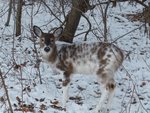
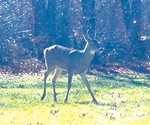
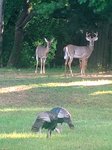

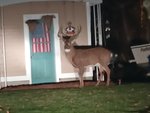
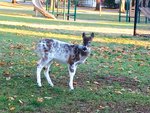
His sparkling white tail bounced up and down a Warwick city street like the lone working tail light of a small vehicle hitting speed humps at nearly 40 miles per hour.
The spike buck avoided the steady traffic on Warwick Avenue, bolted down Wayne Street, through a backyard, finding safety in the grassy field surrounding the quiet Vernon Street Playground.
He stood still for more than 10 minutes, catching his breath near a rusted old Little League backstop. His bright white tail caught fire in the late morning sun; a flash of glowing bleach staining the dark winter tree line.
Deer are thriving in the Ocean State; in cities, suburban neighborhoods and woodland alike. And as the state’s herd swells, over the past decade, hunters have been harvesting more deer in Rhode Island than ever before in the modern era.
“Every night, they’re all over the place — even on the ballfield at City Park,” said Warwick resident and local wildlife enthusiast Art Dunn. “This year I’ve seen so many it’s unbelievable.”
Copious Venison
In 1977, statewide, Rhode Island hunters reported harvesting 157 deer. That number peaked to around 3,000 harvested whitetails in 2008, and has since leveled off to around 2,000 annually, according to the latest Rhode Island Department of Environmental Management (DEM) Division of Fish & Wildlife (DFW) 2021-22 Deer Harvest Report.
Last year’s Ocean State hunting season yielded more than “39 tons of consumable venison, equivalent to about 157,000 meals,” according to the report.
According to a Wall Street Journal survey of state officials and hunting groups (“Hunting Deer in Mating Season Helps Make It One of the Best Years,” Dec. 4 edition), the nation’s “deer hunting season is shaping up as one of the best ever this year, boosted by an early Thanksgiving start, larger than usual herds and favorable weather.”
Although DFW won’t release Rhode Island’s most recent hunting data until early 2023, DEM spokesman Jay Wegimont said this year’s harvest has been high, so far.
“DEM won’t know if Rhode Island’s deer harvest is following the trends mentioned in the Wall Street Journal article until the New Year,” Wegimont explained. “We can say that from date-to-date comparisons, the deer harvest is up this year but the remainder of the year (post-gun season) is highly variable. In RI, the 2022-23 deer season runs from Sept. 10, 2022 (youth weekend), to Feb. 28, 2023. While it is still too early to estimate if RI will have a record year for deer harvest, we are on track to have an increase compared to the 2021-22 season, in which deer hunters reported harvesting 2,164 deer statewide.”
Spotting the Spotted
“This year, by far, there’s many, many more than I used to see — many more than last year,” Dunn said. “I see 10 to 12 every night, easily. They lay down right inside the ball field. I see them jump over the six foot fence like nothing.”
Dunn has been shooting photographs of the deer he spots. Recently, he spotted a family of spotted piebald deer — a relative genetic rarity, with dark spots on a white coat — within the Warwick city limits.
One of the smallest of the piebald family approached Dunn. He admired its almost Dalmatian-like hide.
“There’s three or four of them always out there,” Dunn said. “The little one; that thing comes right up to you. Almost like a pet.”
At least one other piebald deer was spotted in “northern Rhode Island” this year, according to local television news reports.
“Piebald animals, including deer, are rare,” Wegimont said, after conferring with state biologists. “DEM usually receives 2-5 piebald deer reports a year. Piebald deer have blotches of white coloration on portions of their hide that are usually dark in color, normal brown eyes and nose, and black hooves like a normal white-tailed deer. Piebald deer can have varying amounts of white hair. This contrasts with an albino deer, which has an almost all-white coat, a pink nose, and pinkish hooves.”
Piebald deer are members of an elusive class of genetic anomalies roaming our woods and neighborhoods. Many chronic outdoorsmen hunt for a lifetime without spotting a piebald or albino deer in the wild.
“Like albinism, piebaldism is a recessive genetic trait, meaning both parents must carry the trait to have albino or piebald offspring,” Wegimont explained. “The genes responsible for piebald and albino deer are not dominant and oftentimes the deer carrying these genes are biologically inferior to others in the deer herd. Piebaldism occurs in around one percent of the white-tailed deer population, or in other words, around one of every 1,000 deer is a piebald. Albino deer are much rarer than piebald deer; about one in every 30,000 deer is albino.”
Black Powder & White Tails
Wildlife enthusiast Paul Landry lives off Hartford Avenue in Johnston. He’s noticing the same trends in his neighborhood and surrounding areas.
“You see a lot of deer if you go to the right place,” Landry explained. “Johnston’s loaded with deer — Johnston, Scituate, Foster — they’re all loaded with deer. There’s more deer here now than when the pilgrims arrived.”
According to research posted on Small State Big History, a Rhode Island history website (“When Deer Became Extinct in Rhode Island” by Christian McBurney), the Ocean State’s deer population was nearly wiped out centuries ago, but has made an almost miraculous recovery.
“I was shocked to learn that by the late 1700s and well into the late 1800s, deer were extinct in Rhode Island,” McBurney wrote.
The author dug into Roger Williams’s early descriptions of local wildlife (“A Key to the Language of America,” 1643) and “how Native peoples hunted them.”
“Before the arrival of Europeans, Indians hunted for game only as they needed food and clothing,” McBurney wrote. “For generations there was a balance between large mammals and human hunters. The arrival of white settlers radically altered that balance, in Rhode Island, as elsewhere in New England and the rest of the East Coast of North America.”
An influx of settlers, new commerce and new weapons transformed the region’s animal population.
“The fur trade introduced by white Europeans led Indians to increase their hunting of mammals, particularly beaver used for hats in Europe, McBurney wrote. “Guns introduced by Europeans made killing easier for Indians and whites alike. The populations of fur-bearing animals, such as beaver, fox and mink, were decimated. White settlers then began clearing the land to create farms. Numerous forests were cut down and plowed into farms. Many mammals were hunted almost to the brink of extinction including, it is hard to believe today, deer.”
Hunting regulations and wildlife management have led to a booming modern day Rhode Island deer herd.
“Here in Johnston, there’s lots of big bucks,” Landry said. “First of all they’re smart. They adapt to where they live. They adapt to living in places that you wouldn’t think they could live in.”
The 2021-22 DFW Deer Harvest Report recounts the state’s efforts to regenerate the Rhode Island deer heard, going back to the 1950s.
“Since the first regulated hunting season in Rhode Island in 1954, there have been tremendous changes in Rhode Island’s deer population, deer harvest, land use, habitat types, hunter effort, and public perception of wildlife and hunters,” wrote DEM wildlife biologist and report author Dylan Ferreira. “The statewide harvest in 1977 was 157 deer; since then, harvest increased until 2008, peaking at around 3,000 deer. Since 2008, there has been a slight decline to (around) 2,200 deer harvested annually.”
Killing Fields
Most deer were shot, killed, claimed and reported from private land in Rhode Island. According to the DFW report, 72 percent (1,566) of “all deer harvested in RI are harvested on private land,” while the remainder was taken from state Wildlife Management Areas (WMA), federal properties, undeveloped State Parks, and cooperative properties (co-ops) open to hunting.
Hunters reported taking 101 deer from the Arcadia Management Area — overlapping portions of Richmond, Exeter, Hopkinton, and West Greenwich — the highest tally of all state hunting areas.
“The DFW has worked closely with private property owners such as land trusts, The Nature Conservancy, and others to open their lands to deer hunting,” Ferreira wrote. “This is typically allowed to reduce deer densities at the property to mitigate the impacts of high deer densities on habitat.”
Deer season in Rhode Island begins with archery (including crossbows), and runs from mid-September through the end of January. Designated time periods allow hunters to utilize a range of weapons, from bow and arrow, to rifles, shotguns and muzzleloaders. Hunters are allowed to bag “two antlered and multiple antlerless deer across the state.” Rhode Island also now permits hunting on Sundays.
During the 2021-22 deer season, hunters reported harvesting 2,164 deer statewide, an 8 percent decrease from the 2020-21 season harvest of 2,348 deer. Of the year’s harvest, 1,215 (56 percent) were antlered and 949 (44 percent) were antlerless, “the first time since 2010 the antlered harvest exceeded the antlerless harvest.”
“(The) season ended with the largest difference between male (56%) and female (44%) harvest since 2010,” Ferreira wrote. “In addition, the adult male to adult female ratio during check stations was 1.0 to 4.7. The average from the past 10 years was 1.0 to 2.3 female to males. All methods of harvest saw a decrease in harvest except for the muzzleloader harvest. Last season, the archery harvest surpassed the muzzleloader harvest for the time on record, however this year the muzzleloader harvest was highest.”
Responsive Management’s most recent survey of Rhode Island hunters revealed 55 percent of the state’s outdoorsmen “hunt to provide food for their families,” according to the report.
“Wildlife is a renewable resource that when managed properly can provide sustenance in the form of wild, local, sustainable protein year after year to its consumers,” Ferreira wrote. “For each deer harvested, approximately 30 percent of its field dressed body weight is available as consumable venison.”
The state has been testing deer samples for Chronic Wasting Disease for the past two decades.
So far, “CWD has not been detected in any samples submitted for testing during the 20 years of CWD surveillance,” according to Ferreira.
Last year, the state sold 7,559 (not including previously sold, permanent, over-65 licenses) hunting or hunting and fishing combination licenses, according to the report. The state also sold 20,232 deer permits (17,600 sold to state residents, with 2,632 purchased by non-residents).
“Most hunters, both residents and non-residents, purchased two deer permits,” Ferreira wrote. “There were 1,396 successful deer hunters in Rhode Island, with the majority (89%) of hunters harvesting two deer or less. Resident hunters still harvest the most deer in the state, accounting for 1,855 deer, while non-resident hunters harvested 309 deer.”
The average Rhode Island hunter was 48 years old, and “continues to rise annually,” according to the report.
“In 10-20 years, most of today’s hunters will age out, leaving behind a small group of hunters to carry the hunting tradition and financially support wildlife conservation,” Ferreira wrote.
Hunting license sales have dropped 34 percent since 2000, when the state licensed 11,528 hunters and nearly 19,000 deer permits.
“However, there was an increase in this year’s deer hunters (7%) and deer permit (1%) sales,” according to Ferreira. “During the COVID-19 pandemic, Rhode Islanders sought ways to get outside and connect with nature; this small increase in deer hunters and permit sales may be connected to this trend.”
Vehicular Deer-slaughter
National public safety groups estimate vehicles collide with around 1.5 million deer annually in the United States. In Rhode Island in 2021, the state reported 1,285 “deer auto strikes,” up 10 percent over 2020.
“In 2021, the number of reported deer auto strikes was equivalent to 59% of the total reported hunter harvest,” Ferreira wrote, leading to an increase in bag limits in some regions of the state.
Dunn recalled twice in the past few years when he’s been unlucky enough to collide with two pairs of speeding hooves and a white tail.
“In Narragansett one night, on my way to the beach, a deer jumped over a fence and landed on my roof and windshield,” Dunn said. “It rolled off, stood up and ran into the woods. They’re tough as nails. A year later, I hit another at the Yawgoo Ski Area … They’re breeding like crazy.”
Landry has been enjoying the wildlife that seems to be pouring from the wilderness lately — part wildlife habitat restoration success story, part wildlife habitat clearance and destruction tale.
“I recently spotted a bobcat,” Landry said. “It was a whole bobcat family; a mother and three little ones.”
Landry doesn’t drive at night any more. But if he did, he says he’d watch his speed.
“If I do drive, I’ll go slow,” he said. “The trouble is, if you see one coming across the road, you can bet there’s some more right behind them.”
Comments
No comments on this item Please log in to comment by clicking here